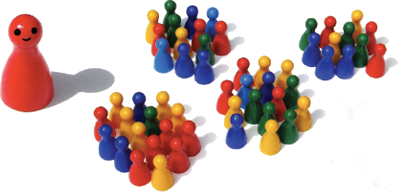Confusion and information triggered by photos in persona profiles
J Salminen, S Jung, J An, H Kwak, L Nielsen, BJ Jansen
International Journal of Human-Computer Studies 129, 1-14 (2019)
L Nielsen, Springer (2019)
DESIGN PERSONAS–NEW WAYS, NEW CONTEXTS
L Nielsen
Persona Studies 4 (2) (2018)
UX in Agile before and during development
MK Larusdottir, L Nielsen, A Bruun, LB Larsen, PA Nielsen, JS Persson
Proceedings of the 10th Nordic Conference on Human-Computer Interaction, 984-987 (2018)
The role of UX professionals in agile development: a case study from industry
A Bruun, MK Larusdottir, L Nielsen, PA Nielsen, JS Persson
Proceedings of the 10th Nordic Conference on Human-Computer Interaction, 352-363 (2018)
“Is More Better?”: Impact of Multiple Photos on Perception of Persona Profiles
J Salminen, L Nielsen, S Jung, J An, H Kwak, BJ Jansen
Proceedings of the 2018 CHI Conference on Human Factors in Computing Systems (2018)
Fixation and Confusion: Investigating Eye-tracking Participants’ Exposure to Information in Personas
J Salminen, BJ Jansen, J An, SG Jung, L Nielsen, H Kwak
Proceedings of the 2018 Conference on Human Information Interaction. (2018)
Who are your users?: comparing media professionals’ preconception of users to data-driven personas
L Nielsen, SG Jung, J An, J Salminen, H Kwak, BJ Jansen
Proceedings of the 29th Australian Conference on Computer-Human Interaction. (2017)
Persona generation from aggregated social media data
SG Jung, J An, H Kwak, M Ahmad, L Nielsen, BJ Jansen
Proceedings of the 2017 CHI conference extended abstracts on human factors. (2017)
I Jensen, H Hautopp, L Nielsen, S Madsen
Journal of Intercultural Communication, 43, (2017)
J Abdelnour-Nocera, L Nielsen, LR Christensen, T Clemmensen
Human-Computer Interaction-INTERACT 2017: Adjunct Proceedings, 254-262 (2017)
“Imagine that…”—How to Activate and Capture Users’ Ability to Think Creatively about Future Use
L Nielsen, S Madsen, A Vorre Hansen
The Role of Creativity in the Management of Innovation: State of the Art and … (2017)
An empirical investigation of the practices and challenges specific to international user studies
S Madsen, L Nielsen, H Hautopp, I Jensen
IFIP Conference on Human-Computer Interaction, 132-148 (2015)
L Nielsen, KS Hansen, J Stage, J Billestrup
International Journal of Sociotechnology and Knowledge Development (IJSKD) 7 …(2015)
Creating and using personas in software development: experiences from practice
J Billestrup, J Stage, A Bruun, L Nielsen, KS Nielsen
International Conference on Human-Centred Software Engineering, 251-258 (2014)
Personas is applicable: a study on the use of personas in Denmark
L Nielsen, K Storgaard Hansen
Proceedings of the SIGCHI Conference on Human Factors in Computing Systems … (2014)
The use of personas in software development: Advantages, obstacles and experiences in practice
J Billestrup, J Stage, L Nielsen, KS Nielsen
The 36th Information Systems Research Conference in Scandinavia (IRIS 36) (2014)
L Nielsen, S Madsen, I Jensen, H Hautopp, L Mulvad
IT-Universitetet i København (2014)
Persona usage in software development: advantages and obstacles
J Billestrup, J Stage, L Nielsen, KS Hansen
Proc. of ACHI, 359-364 (2014)
L Nielsen, KS Nielsen, J Stage, J Billestrup
IFIP Conference on Human-Computer Interaction, 350-357 (2013)
L Nielsen
The encyclopedia of human-computer interaction (2013)
L Nielsen, KS Nielsen
IT University. Technical Report Series (2013)
L Nielsen
Springer (2013)
Personas-From poster to performance
L Nielsen, KS Nielsen
Proceedings of the Participatory Innovation Conference, 272-275 (2013)
Personas in co-creation and co-design
L Nielsen
Proceedings of the 11th Human-Computer Interaction Research Symposium, 38-40 (2011)
Personas in cross-cultural projects
L Nielsen
IFIP Working Conference on Human Work Interaction Design, 76-82. (2009)
Exploring persona-scenarios-using storytelling to create design ideas
S Madsen, L Nielsen
IFIP Working Conference on Human Work Interaction Design, 57-66 (2009)
Using storytelling to improve scenarios
S Madsen, L Nielsen
Proceedings of the IADIS International Conference Information Systems …(2009)
Personas–communication or process
L Nielsen
Proceedings of Seventh Danish HCI Research Symposium 25 (2007)
L Nielsen
Journal of HCI Vistas 3 (2007)
Storytelling as method for sharing knowledge across IT projects
L Nielsen, S Madsen
Proceedings of the 39th Annual Hawaii International Conference on System … (2006)
Using storytelling to reflect on IT projects
L Nielsen, S Madsen
Journal of Information Technology Theory and Application (JITTA) 7 (4), 6 (2006)
L Nielsen
Research Symposium, 68 (2005)
How to use design games to create engaging personas
L Nielsen, E Brandt (2005)
L Nielsen
Computer Interaction Research Symposium, 67 (2004)
L Nielsen
Samfundslitteratur (2004)
A model for personas and scenarios creation
L Nielsen
Roskilde, Denmark 71 (2003)
L Nielsen
Human-computer interaction: theory and practice 430 (2003)
From user to character: an investigation into user-descriptions in scenarios
L Nielsen
Proceedings of the 4th conference on Designing interactive systems … (2002)
L Nielsen
Learning and narrativity in digital media, 165 (2002)
Understanding Users: Merging Video Card Games with Model-users and Scenarios
L Nielsen, G Petersen (2002)
Scenarios: A Design Tool to Ensure User-narratives
L Nielsen
Learning and narrativity in digital media, 165-181 (2002)


